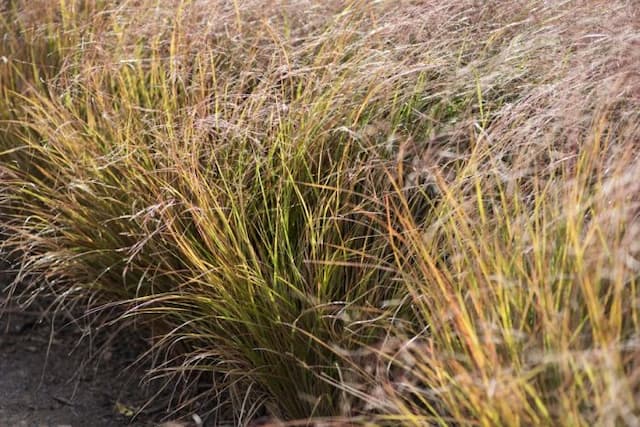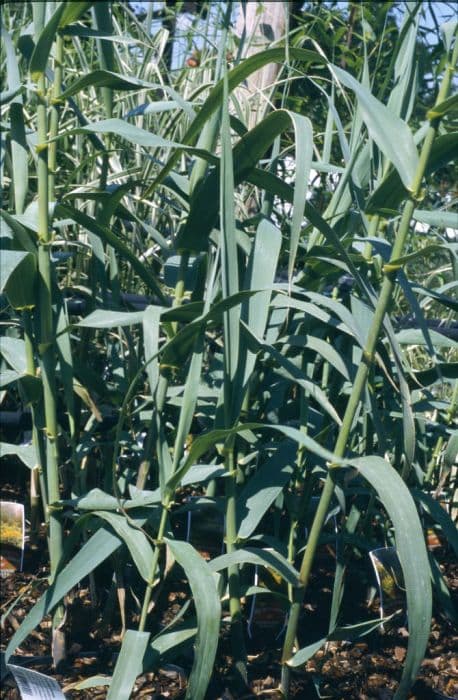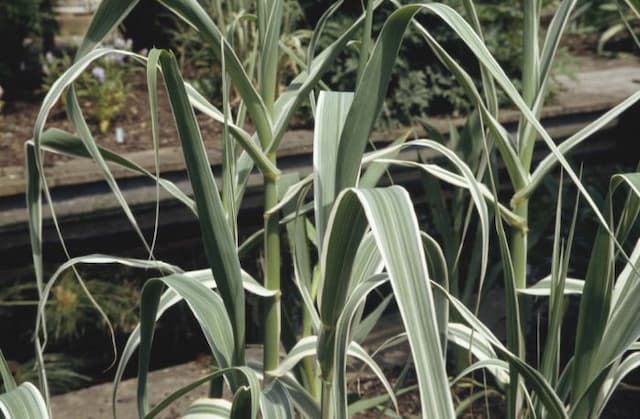Fountain Grass Pennisetum alopecuroides 'Woodside'











ABOUT
Pennisetum alopecuroides 'Woodside', commonly known as fountain grass, is a perennial plant that features a gracefully arching and clumping growth habit which gives it an attractive, fountain-like appearance. The plant produces narrow, lance-shaped, medium to dark green leaves. These leaves have a fine texture and often display a slightly pendulous tip, contributing to the plant's overall weeping form. During the warmer months, fountain grass produces showy, bottlebrush-shaped flower spikes. These spikes emerge a soft, feathery texture and may initially display a purplish hue before maturing to a shade of tan or beige as the season progresses. As the flowers age, they lighten and often persist well into the cooler months, extending the plant's visual interest throughout multiple seasons. In addition to its foliage and flowers, the plant may also feature a notable seed head, which adds a textural element to its appearance. The seed heads can catch the light and create a shimmering effect, especially during the early morning and late afternoon hours. Fountain grass can serve as a strong focal point within a garden or landscape due to its graceful form and dynamic movement. When the plant sways in the breeze, it can add a sense of softness and movement to garden settings, making it popular among gardeners for adding both aesthetic appeal and sensory elements to outdoor spaces.
About this plant
 Names
NamesSynonyms
Fountain Grass, Chinese Fountain Grass, Swamp Foxtail Grass, Foxtail Fountain Grass
Common names
Pennisetum alopecuroides 'Woodside'.
 Toxicity
ToxicityTo humans
Fountain grass, the common name for Pennisetum alopecuroides 'Woodside', is not known to be toxic to humans. Therefore, ingestion of parts of this plant is not typically associated with poisoning symptoms.
To pets
Fountain grass is not recognized for being toxic to pets either. Ingesting this plant should not pose a risk of poisoning to animals such as dogs and cats, and it is not generally known to cause adverse health consequences.
 Characteristics
CharacteristicsLife cycle
Perennials
Foliage type
Deciduous
Color of leaves
Green
Flower color
Beige
Height
2-3 feet (0.6-0.9 meters)
Spread
2-3 feet (0.6-0.9 meters)
Plant type
Grass
Hardiness zones
5-9
Native area
Asia Australia
Benefits
 General Benefits
General Benefits- Landscape Aesthetics: Adds ornamental value to gardens with its feathery flower heads and attractive foliage.
- Drought Tolerance: Can survive with minimal watering once established, making it suitable for xeriscaping.
- Low Maintenance: Requires little care beyond cutting back once a year.
- Erosion Control: Its root system helps stabilize soil and prevent erosion.
- Attracts Wildlife: Provides food and habitat for birds and butterflies.
- Seasonal Interest: Offers visual interest throughout multiple seasons with changing foliage and flower colors.
- Adaptable: Grows in a variety of soil types and conditions ranging from full sun to partial shade.
 Medical Properties
Medical PropertiesThis plant is not used for medical purposes.
 Air-purifying Qualities
Air-purifying QualitiesThis plant is not specifically known for air purifying qualities.
 Other Uses
Other Uses- As a natural dye source: The foliage of Fountain Grass can be used to produce a natural dye for fabric, offering a sustainable alternative to chemical dyes.
- Sound insulation: Dense plantings of Fountain Grass can act as a sound buffer in noisy areas, reducing the impact of traffic or industrial noise.
- Erosion control: The robust root system of Fountain Grass helps stabilize soil on slopes and banks, preventing erosion.
- Thatching material: The dry leaves of Fountain Grass can be used as a traditional thatching material for roofing in some cultures.
- Craft material: Dried stems of Fountain Grass can be incorporated into floral arrangements or used to make wreaths and other decorative items.
- Biological pest control: Fountain Grass can be a habitat for predatory insects that control pest populations, promoting a healthy garden ecosystem.
- Fish habitat: When used in pondscaping, the submerged parts of Fountain Grass can provide shelter and breeding areas for fish.
- Photography: Fountain Grass's distinctive seed heads and foliage serve as an excellent subject for nature photographers and artists.
- Privacy screening: Tall varieties of Fountain Grass can be planted to provide privacy in a natural and aesthetically pleasing way.
- Livestock fodder: In some regions, Fountain Grass may be used as fodder for livestock, though it's not the most nutritious option.
Interesting Facts
 Feng Shui
Feng ShuiThe Fountain Grass is not used in Feng Shui practice.
 Zodiac Sign Compitability
Zodiac Sign CompitabilityThe Fountain Grass is not used in astrology practice.
 Plant Symbolism
Plant Symbolism- Grace and Flexibility: The flowing, fountain-like shape of the Chinese Fountain Grass embodies grace and the ability to adapt and sway with life's changes, similar to its movement in the breeze.
- Resilience: This grass thrives in a variety of conditions, symbolizing the capacity to endure and prosper regardless of circumstances.
- Peace and Serenity: The soft textures and gentle movement of Chinese Fountain Grass can evoke a sense of calmness and relaxation, making it associated with peaceful environments.
- Growth and Abundance: With its lush foliage and propensity for growth, it is often seen as a symbol of abundance and prosperity.
- Privacy and Boundaries: As Chinese Fountain Grass can form dense clumps, it is sometimes used to symbolize the setting of personal boundaries and creating private spaces.
 Water
WaterFountain grass prefers consistent moisture but is also drought tolerant once established. Water new plants thoroughly to establish a deep, extensive root system, using about 1 inch of water once a week. During hot, dry periods, water may be needed twice a week but be careful not to overwater as fountain grass does not like soggy soils. Reduce watering frequency once the plant is established, but provide a deep soak during extended dry spells. In general, aim to provide about 1 gallon per week for each square foot the plant covers.
 Light
LightFountain grass thrives in full sun where it receives at least 6 hours of direct sunlight each day. While it can tolerate some light shade, the fullest and most robust growth occurs in sunny spots. Avoid places that are shaded for most of the day, as too little light can result in thin, floppy growth.
 Temperature
TemperatureFountain grass is hardy in temperatures typically ranging from 20°F in the winter to over 90°F during the summer months, but it grows best when daytime temperatures are between 70°F and 90°F. It can survive in USDA hardiness zones 5 through 9, making it quite adaptable to a range of temperature conditions.
 Pruning
PruningPrune fountain grass in late winter or early spring to remove old growth and make way for new shoots. Trimming back the plant to about 4-6 inches above the ground annually will help maintain a tidy appearance and promote healthy, vigorous growth. Pruning is best done before new growth begins, usually when the temperature regularly stays above freezing.
 Cleaning
CleaningAs needed
 Soil
SoilFountain Grass prefers well-draining soil with a slightly acidic to neutral pH, usually between 5.5 and 7.0. The best soil mix for Fountain Grass would be a combination of loamy soil, compost, and a small amount of sand or perlite to improve drainage.
 Repotting
RepottingFountain Grass typically does not need to be repotted often as it thrives when root-bound. It should be repotted every 2-3 years or when the plant outgrows its current container.
 Humidity & Misting
Humidity & MistingFountain Grass is tolerant of a wide range of humidity levels and does not have specific humidity requirements. Average room humidity is generally suitable for this grass.
 Suitable locations
Suitable locationsIndoor
Place in bright light and maintain average room temperature for indoor Fountain Grass.
Outdoor
Plant in full sun to partial shade and water deeply but infrequently.
Hardiness zone
5-9 USDA
 Life cycle
Life cyclePennisetum alopecuroides 'Woodside', commonly known as Woodside Fountain Grass, begins its life cycle as a seed, which, when sown in fertile, well-drained soil and with adequate warmth, will germinate to produce a seedling. The seedling grows into an ornamental clump-forming perennial and enters a vegetative stage, developing long, narrow leaves and gaining height and girth. During its growth phase, particularly in the summer to early fall, it produces fuzzy, bottlebrush-like flower spikes that rise above the foliage and can add aesthetic value to gardens. After blooming, the plant enters a period of senescence where the flowers turn brown and the foliage begins to die back, especially as temperatures decrease in fall. In the dormant stage over winter, the foliage may completely die back, depending on the climate, but the roots remain alive underground. In the following spring, Woodside Fountain Grass will resume growth from the crown, restarting the cycle.
 Propogation
PropogationPropogation time
Spring to Summer
The most popular method to propagate the Chinese Fountain Grass, Pennisetum alopecuroides 'Woodside', is by division. This process is best carried out during the plant's active growth period, generally in the spring or early summer. To propagate by division, carefully dig up the grass clump and gently pull apart or cut through the root mass to create smaller sections, each with a portion of the roots and several shoots. These sections can then be immediately replanted at the same depth they were originally growing and should be watered thoroughly after planting to help establish them. Division not only helps to create new plants but can also rejuvenate older clumps that might have become woody or less vigorous, encouraging fresh growth.









